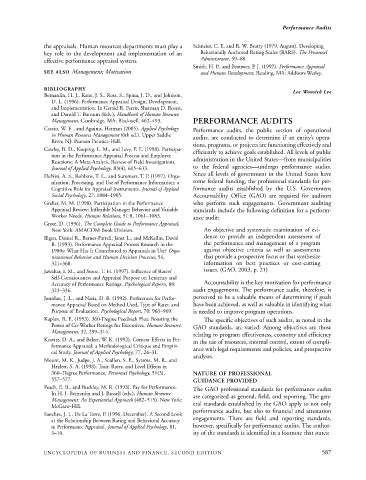Page 610 - Encyclopedia of Business and Finance
P. 610
eobf_P 7/5/06 3:18 PM Page 587
Performance Audits
the appraisals. Human resources departments must play a Schneier, C. E. and R. W. Beatty (1979, August). Developing
key role in the development and implementation of an Behaviorally Anchored Rating Scales (BARS). The Personnel
effective performance appraisal system. Administrator, 59–68.
Smith, H. P., and Brouwer, P. J. (1997). Performance Appraisal
SEE ALSO Management; Motivation and Human Development, Reading, MA: Addison-Wesley.
BIBLIOGRAPHY Lee Wonsick Lee
Bernardin, H. J., Kane, J. S., Ross, S., Spina, J. D., and Johnson,
D. L. (1996). Performance Appraisal Design, Development,
and Implementation. In Gerald R. Ferris, Sherman D. Rosen,
and Darold T. Barnum (Eds.), Handbook of Human Resource
Management, Cambridge, MA: Blackwell, 462–493. PERFORMANCE AUDITS
Cascio, W. F. , and Aguinis, Herman (2005). Applied Psychology Performance audits, the public version of operational
in Human Resource Management (6th ed.). Upper Saddle audits, are conducted to determine if an entity’s opera-
River, NJ: Pearson Prentice-Hall.
tions, programs, or projects are functioning effectively and
Cawley, B. D., Keeping, L. M., and Levy, P. E. (1998). Participa- efficiently to achieve goals established. All levels of public
tion in the Performance Appraisal Process and Employee
Reactions: A Meta-Analytic Review of Field Investigations. administration in the United States—from municipalities
Journal of Applied Psychology, 83(4), 615–633. to the federal agencies—undergo performance audits.
Since all levels of government in the United States have
DeNisi, A. S., Robbins, T. L., and Summers, T. P. (1997). Orga-
nization, Processing, and Use of Performance Information: a some federal funding, the professional standards for per-
Cognitive Role for Appraisal Instruments. Journal of Applied formance audits established by the U.S. Government
Social Psychology, 27, 1884–1905. Accountability Office (GAO) are required for auditors
Greller, M. M. (1998). Participation in the Performance who perform such engagements. Government auditing
Appraisal Review: Inflexible Manager Behavior and Variable standards include the following definition for a perform-
Worker Needs. Human Relations, 51:8, 1061–1083. ance audit:
Grote, D. (1996). The Complete Guide to Performance Appraisal,
New York: AMACOM Book Division. An objective and systematic examination of evi-
Illgen, Daniel R., Barnes-Farrell, Janet L., and McKellin, David dence to provide an independent assessment of
B. (1993). Performance Appraisal Process Research in the the performance and management of a program
1980s: What Has It Contributed to Appraisals in Use? Orga- against objective criteria as well as assessments
nizational Behavior and Human Decision Processes, 54, that provide a prospective focus or that synthesize
321–368. information on best practices or cost-cutting
Jawahar, I. M., and Stone, T. H. (1997). Influence of Raters’ issues. (GAO, 2003, p. 21)
Self-Consciousness and Appraisal Purpose on Leniency and
Accuracy of Performance Ratings. Psychological Reports, 80: Accountability is the key motivation for performance
323–336. audit engagements. The performance audit, therefore, is
Jourdan, J. L., and Nasis, D. B. (1992). Preferences for Perfor- perceived to be a valuable means of determining if goals
mance Appraisal Based on Method Used, Type of Rater, and have been achieved, as well as valuable in identifying what
Purpose of Evaluation. Psychological Report, 70: 963–969. is needed to improve program operations.
Kaplan, R. E. (1993). 360-Degree Feedback Plus: Boosting the The specific objectives of such audits, as noted in the
Power of Co-Worker Ratings for Executives. Human Resource GAO standards, are varied. Among objectives are those
Management, 32, 299–314.
relating to program effectiveness, economy and efficiency
Kravitz, D. A., and Balzer, W. K. (1992). Context Effects in Per- in the use of resources, internal control, extent of compli-
formance Appraisal: a Methodological Critique and Empiri- ance with legal requirements and policies, and prospective
cal Study. Journal of Applied Psychology, 77, 24–31.
analyses.
Mount, M. K., Judge, J. A., Scullen, S. E., Sytsma, M. R., and
Hezlett, S. A. (1998). Trait, Rater, and Level Effects in
360–Degree Performance. Personnel Psychology, 51(3), NATURE OF PROFESSIONAL
557–577. GUIDANCE PROVIDED
Peach, E. B., and Buckley, M. R. (1993). Pay for Performance. The GAO professional standards for performance audits
In H. J. Bernardin and J. Russell (eds.), Human Resource are categorized as general, field, and reporting. The gen-
Management: An Experiential Approach (482–515). New York:
McGraw-Hill. eral standards established by the GAO apply to not only
performance audits, but also to financial and attestation
Sanches, J. I., De La Torre, P. (1996, December). A Second Look
at the Relationship Between Rating and Behavioral Accuracy engagements. There are field and reporting standards,
in Performance Appraisal. Journal of Applied Psychology, 81, however, specifically for performance audits. The author-
3–10. ity of the standards is identified in a footnote that states:
ENCYCLOPEDIA OF BUSINESS AND FINANCE, SECOND EDITION 587

